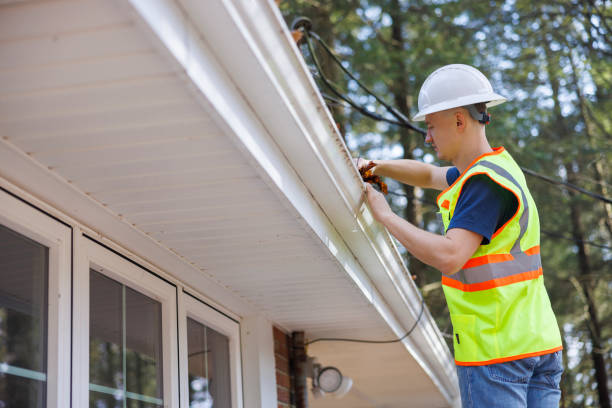Let’s imagine it’s a rainy evening, and you’re watching the water pour right off your roof, soaking the walls below. That’s when you realize how important Gutters installation really is. With a well planned setup, every drop finds its way safely to the ground, protecting your home from leaks and cracks that could cause costly damage later on.
In this post, we guide you through each step from selecting the right materials to fitting them securely in place. You’ll learn how a few simple efforts can turn a messy downpour into a smooth, well managed flow that keeps your home dry, safe, and ready for every rainy season.
Table of Contents
Essential Guide to Gutters Installation
Many homeowners underestimate the role of a properly installed gutter system. Gutters are not just metal strips along the roof; they are your home’s first defense against water damage. They channel rainwater away from your walls, windows, and foundation, preventing erosion, mold, and structural weakening.
When gutters fail or are missing entirely, water can seep into basements, ruin landscaping, and cause cracks in foundations. Repairing such issues can cost far more than installing or maintaining gutters in the first place. That’s why investing in professional service is a smart and preventive step for long term protection.

The Real Value of Hiring Professionals
While some homeowners prefer DIY methods, professional services bring precision, safety, and durability. Experts understand roof slopes, water flow, and the right gutters installation dimensions for your home. They use specialized tools to ensure proper alignment and sealing, which prevents leaks and overflow.
Professionals also handle high roofs and tricky angles safely areas where DIY attempts can turn dangerous. Moreover, experienced installers can assess the condition of fascia boards, recommend guards, and spot early signs of roof wear before it becomes costly.
Step-by-Step Look at the gutters Installation Process
1. Inspection and Measurement
The process begins with a full roofline inspection. Experts measure roof edges and note where downspouts should be positioned to manage water efficiently. Proper slope calculation is critical here even a minor misalignment can cause pooling or overflow.
2. Material Selection
There’s a variety of options available: aluminum, copper, steel, and vinyl. Professionals help you choose based on climate, house design, and budget. Aluminum is lightweight and rust-resistant; copper adds elegance but costs more.
3. Custom Cutting and Shaping
Professional installers cut gutters precisely to match each side of your roofline. Seamless systems are crafted on-site, reducing the risk of leaks between joints.
4. Mounting and Sealing
Next comes secure attachment using brackets spaced evenly to hold weight during heavy rain. Sealants are applied at corners and joints to prevent drips.
5. Downspout Placement
Downspouts guide water away from the foundation. Proper positioning ensures even flow and avoids puddles near the home. Professionals test everything before final tightening to guarantee reliability.
Choosing the Right Material
Every home is different, and the climate plays a major role in material choice:
- Aluminum: Affordable, rust-resistant, and easy to maintain.
- Copper: Durable, adds beauty, and develops a natural patina over time.
- Steel: Strong and reliable for heavy rainfall areas, though it may require repainting.
- Vinyl: Budget-friendly but better suited for mild climates.
A professional will balance performance, appearance, and longevity to recommend what best fits your home’s structure.
Common Problems Caused by Poor Installation
Improper slope or loose mounting can lead to several problems:
- Water overflowing and damaging siding.
- Leaks causing mold inside walls.
- Sagging gutters from incorrect bracket spacing.
- Erosion near foundations from misdirected downspouts.
Hiring experts avoids these costly issues through precision measurement and durable mounting.
How Regular Maintenance Extends Lifespan
Even the best installation requires upkeep. Professionals recommend cleaning twice a year spring and autumn to remove leaves, nests, or dirt that block water flow.
Adding gutter guards can minimize debris buildup, while routine inspections catch early rust or cracks. With consistent care, your system can last 20 years or more without major repair.
Seasonal Considerations
Spring and Summer
Inspect for winter damage, ensure proper drainage, and clear blockages from storms or pollen buildup.
Autumn
This is peak season for falling leaves. Install guards or schedule cleanings to prevent overflow during early winter rains.
Winter
In colder climates, ice dams can form. Proper insulation and professional setup prevent melting snow from refreezing inside the gutter.
Environmental and Aesthetic Advantages
Beyond protection, well-designed systems improve your home’s curb appeal. Modern materials come in various colors and finishes to match roofs and trims. Some homeowners even opt for rainwater collection setups, reusing water for gardening an eco-friendly plus that reduces waste.
Professionals can integrate these designs neatly, ensuring your system not only functions perfectly but also enhances the overall look of your property.
Signs It’s Time to Replace Your Gutters
- Persistent leaks even after repairs.
- Peeling paint or rust spots.
- Sagging sections that pull away from the roofline.
- Pools of water near the foundation after rain.
If you notice any of these, a new professional setup ensures peace of mind before further damage occurs.
How to Choose a Reliable Service Provider
- Check Experience: Look for companies with proven track records in gutter and roofing services.
- Read Reviews: Customer feedback reveals reliability, punctuality, and quality of work.
- Request Estimates: Compare quotes, but value expertise over the lowest price.
- Ask About Warranty: A reputable installer provides a warranty on both materials and workmanship.
- Verify Insurance: Always confirm that the company is licensed and insured for property and worker safety.
These steps save you from poor workmanship and unnecessary future repairs.
Cost Factors Explained
Prices vary depending on materials, home size, roof height, and complexity. Seamless systems or copper gutters cost more upfront but provide better longevity. Professional labor ensures the investment pays off through fewer maintenance issues and increased property value.
Getting a detailed quote upfront helps plan your budget effectively. Transparent professionals break down material, labor, and accessory costs clearly.
Long-Term Benefits of Professional Installation
- Durability: Precision installation prevents leaks and sagging.
- Safety: No need to climb ladders or handle power tools yourself.
- Aesthetics: Clean lines and perfect fitting enhance home beauty.
- Value: Proper drainage prevents costly structural damage, protecting your investment.
When professionals handle the job, you gain not only a working system but also peace of mind that lasts for years.
Smart Add-Ons to Consider
- Gutter Guards: Reduce cleaning frequency and stop debris buildup.
- Heated Cables: Prevent ice dams in colder regions.
- Rain Chains: Stylish alternatives to traditional downspouts.
- Rain Barrels: Collect and reuse water for gardens or lawns.
Such add-ons improve function, sustainability, and even design appeal.
Safety Measures During Installation
Professional crews follow strict safety standards: securing ladders, wearing harnesses, and avoiding electrical hazards. They also protect surrounding landscaping and ensure old materials are disposed of responsibly. These precautions protect both property and workers throughout the process.
Conclusion
A well planned gutter system is more than a finishing touch it’s a shield protecting your home from the constant threat of rainwater damage. Professional installers bring the right tools, skills, and precision that DIY methods can rarely match. From material selection to final testing, each step ensures strength, style, and security.
When you invest in expert service, you invest in your home’s future a simple choice that prevents big problems later. The result is a cleaner exterior, a drier foundation, and peace of mind every time it rains.

